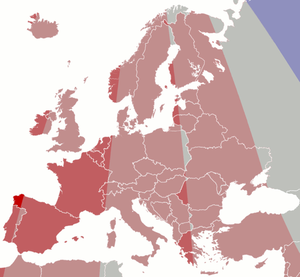Eastern European Summer Time
Appearance
UTC) Western European Summer Time / British Summer Time / Irish Standard Time (UTC+1) Red Central European Time (UTC+1) Central European Summer Time (UTC+2) Yellow Eastern European Time / Kaliningrad Time (UTC+2) Ochre Eastern European Time (UTC+2) Eastern European Summer Time (UTC+3) Green Moscow Time / Turkey Time (UTC+3) Turquoise Armenia Time / Azerbaijan Time / Georgia Time / Samara Time (UTC+4) ▉▉▉▉ Pale colours: Standard time observed all year
▉▉▉ Dark colours: Summer time
observed▉▉▉ Dark colours: Summer time
Eastern European Summer Time (EEST) is one of the names of the
Arabia Standard Time, East Africa Time, and Moscow Time. During the winter periods, Eastern European Time (UTC+02:00
) is used.
Since 1996,
European Summer Time has been applied from the last Sunday in March to the last Sunday in October. Previously, the rules were not uniform across the European Union.[1]
Usage
The following countries and territories use Eastern European Summer Time during the summer:
- Moscow Summer Timein years 1981–89, regular EEST from 1991-2011
- Bulgaria, regular EEST since 1979
- Cyprus, regular EEST since 1979 (Northern Cyprus stopped using EEST in September 2016, but returned to EEST in March 2018[2])
- Moscow Summer Timein years 1981–88, regular EEST since 1989
- Egypt, since 2023
- Finland, regular EEST since 1981
- Greece, regular EEST since 1975
- Israel Daylight Timesince 1948 (which tracks EEST when the two overlap)
- Jordan, since 1985
- Moscow Summer Timein years 1981–88, regular EEST since 1989
- Lebanon, since 1984
- Moscow Summer Time in years 1981–88, regular EEST since 1989, apart from in years 1998-2003 when it was Central European Summer Time
- Moscow Summer Timein years 1932–40 and 1981–89, regular EEST since 1991
- Romania, unofficial EEST in years 1932–40, regular EEST since 1979
- Moscow Summer Timein years 1981–90, regular EEST since 1991, as standard time from March 2011.
- Syria, since 1983
- Moscow Summer Time in years 1981–89, regular EEST from 1992[3]
In 1991, EEST was used also in
Moscow Summer Time
in 1979–1983, and EEST in 1985–2016.
| Colour | Legal time vs. local mean time |
|---|---|
| 1 h ± 30 m behind | |
| 0 h ± 30 m | |
| 1 h ± 30 m ahead | |
| 2 h ± 30 m ahead | |
| 3 h ± 30 m ahead |

See also
- European Summer Time
- UTC+03:00
References
- ^ Joseph Myers (2009-07-17). "History of legal time in Britain". Retrieved 2009-10-11.
- ^ Time zones in North Nicosia
- ^ Ukraine to return to standard time on Oct. 30 (updated), Kyiv Post (October 18, 2011)
